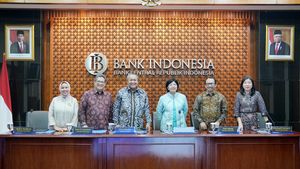JAKARTA - Head of the National Family Planning Coordination Agency (BKKBN) Hasto Wardoyo said he was grateful that the number of residents aged 0-7 years or the post-gen z generation was below the figure previously estimated.
This data is seen by Hasto from the population census of the Central Statistics Agency (BPS) as of September 2020. Based on the data, the post-gen z generation is recorded at 10.88 percent of the total population today.
"BPS data shows that the post-gen z generation figures are 29.17 million. Of course I see this as a bit optimistic and happy, a little excited," said Hasto in a virtual discussion, Thursday, February 4.
The BKKBN estimate for births per year of age per census period is at 5 million people. So, it was estimated that the age of 0 to 7 years was at 35 million at the time of the 2020 population census. However, currently the figure is below the estimate.
Looking at this data, Hasto argues that the birth rate is currently slowing down a bit. This has a positive impact on a country with a densely populated population like Indonesia.
"For us, it is a sense of gratitude because a few years earlier, the age was less than 7 years, the age was approximately 5 million each year. This shows that there are not only about 4.5 million people per year of age," said Hasto.
Then, the population with the zet gene category or those who are now 8 to 23 years old is 27.94 percent, the millennial generation or 24 to 39 years old is 25.87 percent, generation x or 40 to 55 years old is 21.88 percent, baby boomers or 56 to 74 years old by 11.56 percent, and pre boomers or over 75 years of age by 1.87 percent.
For information, BPS recorded the total population of Indonesia based on the September 2020 census as many as 270.20 million people. Meanwhile, the population growth rate from 2010 to 2020 was 1.25 million people.
Indonesia's population growth rate has slowed down from the census results every 10 years in the previous period. In the 1990 census, the population growth rate was 1.98. In 2000, the rate was 1.44. In 2010, the rate was 1.49. In 2020, the rate is 1.25.
However, although the population growth rate has decreased from 1.49 to 1.25, the total fertility rate has not decreased significantly and has been relatively stable in the last 5 years. The birth rate was 16.4 per 1,000 population, while the death rate was 6.1 per 1,000 population.
"On this occasion I tell all in the BKKBN not to be too happy, because we must remember that our fertility is still quite high," he concluded.
The English, Chinese, Japanese, Arabic, and French versions are automatically generated by the AI. So there may still be inaccuracies in translating, please always see Indonesian as our main language. (system supported by DigitalSiber.id)













